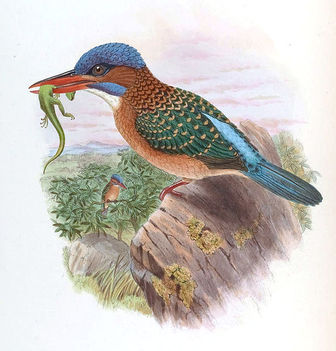Blue-capped Kingfisher
Its natural habitats are subtropical or tropical moist lowland forests and subtropical or tropical moist montane forests. It is threatened by habitat loss.

The Blue-capped Kingfisher is classified as Vulnerable (VU), considered to be facing a high risk of extinction in the wild.
The blue-capped kingfisher is a stunning bird named for its dark purple-blue crown. It has a ‘moustache’ of the same colour, and a prominent, dagger-shaped, red bill. Its cheeks and underparts are burnt-orange and the throat is white. The plumage ... More
The blue-capped kingfisher has a restricted range in which its forest habitat is rapidly disappearing, causing a decline in population numbers (2) (4). In the late 1980s, Mindanao retained only 29 percent of its original forest cover, and further loss and degradation has taken place since (6). Slash-and-burn agriculture, harvesting of non-timber forest products such as rattan and palm, logging operations and mining activities, have all played their part in the destruction of Mindanao’s forests and the kingfisher’s home. More
Tried Blue-capped Kingfisher with Chris at dawn, no luck. We continued ... http://www.birdtours.co.uk/tripreports/philippines/philippines3/Philippines%20-%20frontpage.htm Birdwatching Trip Report from The Philippines: We had some luck with bad views of a Blue-capped Kingfisher, but a pair of Rufous-headed tailorbirds was well seen. Then we went ... http://www.kingbirdtours.com/news.html KingBird Tour News: Other birds at the site were Mindanao Racquet-tail, Mindanao Scops-Owl, Mindanao Eagle-Owl, Blue-capped Kingfisher and Apo Sunbird. ... http://www.worldwildlife.org/wildworld/profiles/terrestrial/im/im0128_full. More
Blue-capped Kingfisher which gave prolonged close views and capped a fine kingfisher day with Rufous-lored Kingfishers already seen the same day at dawn and Silvery Kingfishers later enjoyed on a small roadside pond. The more open secondary forest and scrub is the favoured habitat of the skulking Little Slaty Flycatcher which we tracked thanks to its sweet sang, finding the difficult Rufous-tailed Jungle Flycatcher in the process. More
The Blue-capped Kingfisher (Actenoides hombroni) is a species of bird in the Alcedinidae family. It is endemic to the Philippines. Its natural habitats are subtropical or tropical moist lowland forests and subtropical or tropical moist montanes. It is threatened by habitat loss. http://en.wikipedia.org/wiki/Blue-capped_Kingfisher The text in this page is based on the copyrighted Wikipedia article shown in above URL. It is used under the GNU Free Documentation License. More
with bad views of a Blue-capped Kingfisher, but a pair of Rufous-headed tailorbirds was well seen. Then we went to the second site for the Bagobo Babbler and Blue-capped Kingfisher (see map 1). There we suddenly heard the cry of the Philippine Eagle, so we ran into the open and started scanning the forested slopes. Immediately Leo saw the beast sitting and we watched this magnificent bird for an hour. Also present there was a Philippine Serpent-Eagle and a probable Rufous-bellied Eagle. More
Again a Blue-capped Kingfisher was seen and a Flame-crowned Flowerpecker. The Philippine Eagle was calling again, but was not seen. At 14:30 we left the lodge, leaving Pete behind. A lot of horses and luggage of Birdquest arrived. The large bottles of cold Coca Cola looked very tempting, but we managed to control ourselves. After a less then two hours walk (not so hard as the way-up) we arrived at 16.00 at Carlito More
Family : Alcedinidae
Genus : Actenoides
Species : hombroni
Authority : (Bonaparte, 1850)

